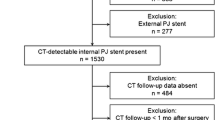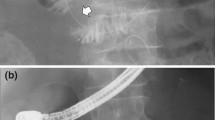Abstract
Contemporary treatment programs for patients with potentially resectable pancreatic cancer often involve preoperative therapy. When the duration of preoperative therapy exceeds 2 months, the risk of plastic endobiliary stent occlusion increases. Metal stents have much better patency but may complicate subsequent pancreaticoduodenectomy (PD). We evaluated rates of perioperative morbidity, mortality, and stent complications in 272 consecutive patients who underwent PD at our institution from May 2001 to November 2004. Of these 272 patients, 29 (11%) underwent PD after placement of a metal stent, 141 underwent PD after placement of a plastic stent, 10 had PD after biliary bypass without stenting, and 92 had PD without any form of biliary decompression. No differences were found between the Metal Stent group and all other patients in median operative time, intraoperative blood loss, or length of hospital stay. No perioperative deaths occurred in the Metal Stent group versus 3 (1.2%) deaths in the other 243 patients. The incidence of major perioperative complications was similar between the two groups, including the rates of pancreatic fistula, intra-abdominal abscess, and wound infection. Furthermore, there were no differences in the perioperative morbidity or mortality rates between patients who underwent preoperative biliary decompression with a stent of any kind (metal or plastic) and those patients who underwent no biliary decompression at all. Metal stent-related complications occurred in 2 (7%) of 29 patients during a median preoperative interval of 4.1 months; in contrast, 75 (45%) of the 166 patients who had had plastic stents experienced complications, including 98 stent occlusions, during a median preoperative interval of 3.9 months (P < 0.001). We conclude that the use of expandable metal stents does not increase PD-associated perioperative morbidity or mortality, and as such an expandable metal stent is our preferred method of biliary decompression in patients with symptomatic malignant distal bile duct obstruction in whom surgery is not anticipated, or in whom there is a significant delay in the time to surgery.
Similar content being viewed by others
References
Povoski SP, Karpeh MS Jr, Conlon KC, Blumgart LH, Brennan MF. Association of preoperative biliary drainage with postoperative outcome following pancreaticoduodenectomy. Ann Surg 1999;230:131–142.
Heslin MJ, Brooks AD, Hochwald SN, Harrison LE, Blumgart LH, Brennan MF. A preoperative biliary stent is associated with increased complications after pancreatoduodenectomy. Arch Surg 1998;133:149–154.
Sohn TA, Yeo CJ, Cameron JL, Pitt HA, Lillemoe KD. Do preoperative biliary stents increase postpancreaticoduodenectomy complications? J Gastrointest Surg 2000;4:258–267; discussion 267-268.
Pisters PW, Hudec WA, Hess KR, et al. Effect of preoperative biliary decompression on pancreaticoduodenectomyassociated morbidity in 300 consecutive patients. Ann Surg 2001;234:47–55.
Raut CP, Evans DB, Crane CH, Pisters PW, Wolff RA. Neoadjuvant therapy for resectable pancreatic cancer. Surg Oncol Clin N Am 2004;13:639–661, ix.
Evans DB, Rich TA, Byrd DR, et al. Preoperative chemoradiation and pancreaticoduodenectomy for adenocarcinoma of the pancreas. Arch Surg 1992;127:1335–1339.
Breslin TM, Hess KR, Harbison DB, et al. Neoadjuvant chemoradiotherapy for adenocarcinoma of the pancreas: treatment variables and survival duration. Ann Surg Oncol 2001;8:123–132.
Pisters PW, Wolff RA, Janjan NA, et al. Preoperative paclitaxel and concurrent rapid-fractionation radiation for resectable pancreatic adenocarcinoma: toxicities, histologic response rates, and event-free outcome. J Clin Oncol 2002; 20:2537–2544.
Pisters PW, Hudec WA, Lee JE, et al. Preoperative chemoradiation for patients with pancreatic cancer: toxicity of endobiliary stents. J Clin Oncol 2000;18:860–867.
Davids PH, Groen AK, Rauws EA, Tytgat GN, Huibregtse K. Randomised trial of self-expanding metal stents versus polyethylene stents for distal malignant biliary obstruction. Lancet 1992;340:1488–1492.
Kaassis M, Boyer J, Dumas R, et al. Plastic or metal stents for malignant stricture of the common bile duct? Results of a randomized prospective study. Gastrointest Endosc 2003; 57:178–182.
Wasan SM, Ross WA, Staerkel GA, Lee JH. Use of expandable metallic biliary stents in resectable pancreatic cancer. Am J Gastroenterol 2005;100:2056–2061.
Yen TWF, Abdalla EK, Pisters PWT, Evans DB. Pancreaticoduodenectomy. In: Von Hoff DD, Evans DB, Hruban RH, eds. Pancreatic Cancer. Sudbury, MA: Jones and Bartlett, 2005, pp 265–285.
Wolff RA, Evans DB, Crane CH, et al. Initial results of preoperative gemcitabine (GEM)-based chemoradiation for resectable pancreatic adenocarcinoma. Proc Am Soc Clin Oncol 2002;21:516a.
Porter GA, Pisters PW, Mansyur C, et al. Cost and utilization impact of a clinical pathway for patients undergoing pancreaticoduodenectomy. Ann Surg Oncol 2000;7:484–489.
Tseng JF, Raut CP, Lee JE, et al. Pancreaticoduodenectomy with vascular resection: margin status and survival duration. J Gastrointest Surg 2004;8:935–949; discussion 949–950.
Wolff RA, Abbruzzese JL, Evans DB. Neoplasms of the exocrine pancreas. In: Holland JF, Frei E, Bast RC, Kufe DW, Pollock RE, Weichselbaum RR, eds. Cancer Medicine. Ontario: BC Decker, 2003, pp 1585–1614.
Evans DB, Abbruzzese JL, Willett CG. Cancer of the pancreas. In: DeVita VT, Hellman S, Rosenberg SA, eds. Cancer, Principles and Practice of Oncology. Philadelphia: Lippincott Williams and Wilkins, 2001, pp 1126–1161.
Prat F, Chapat O, Ducot B, et al. A randomized trial of endoscopic drainage methods for inoperable malignant strictures of the common bile duct. Gastrointest Endosc 1998;47:1–7.
Isayama H, Komatsu Y, Tsujino T, et al. A prospective randomised study of "covered" versus "uncovered" diamond stents for the management of distal malignant biliary obstruction. Gut 2004;53:729–734.
Kahaleh M, Tokar J, Le T, Yeaton P. Removal of selfexpandable metallic Wallstents. Gastrointest Endosc 2004; 60:640–644.
Author information
Authors and Affiliations
Corresponding author
Additional information
Supported by the Lockton Fund for Pancreatic Cancer Research, The University of Texas M. D. Anderson Cancer Center, Houston, Texas.
Rights and permissions
About this article
Cite this article
Mullen, J.T., Lee, J.H., Gomez, H.F. et al. Pancreaticoduodenectomy after placement of endobiliary metal stents. J Gastrointest Surg 9, 1094–1105 (2005). https://doi.org/10.1016/j.gassur.2005.08.006
Issue Date:
DOI: https://doi.org/10.1016/j.gassur.2005.08.006




